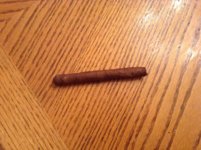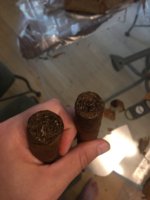You are using an out of date browser. It may not display this or other websites correctly.
You should upgrade or use an alternative browser.
You should upgrade or use an alternative browser.
Pics of your sticks!!
- Thread starter Indianamac
- Start date
- Status
- Not open for further replies.
RexLaughlin
Member
a quickie test gar for the morning:

Lookin for a stash-worthy blend
The core is 1 Nic hab ligero
surrounded by Don's fine T-13 viso
bound in WLT Dom binder
wrapped in FXSS CT leaves formerly rejected for plumpfectos because of flaws
we'll soon know how tastily it smolders
What a beauty!!!!
Snowblithe
Moderator
Cigar number 7 and 8 here. I had to double up the binder on the first one I rolled today but the second one worked with just one. I’m obviously not too concerned about getting a specific gauge just yet but they look to me to be about 56 and 52 respectively. Now to see how they smoke.
Also, I’m not sure if this is the place to post questions, but what do you folks use as a bunching technique? Do you roll up a bit of filler and then roll that in the remainder or what? I’ve kinda been just stacking the filler and rolling all at once, which seems to burn okay but one of my sticks had a pretty bad run in it.
Also, I’m not sure if this is the place to post questions, but what do you folks use as a bunching technique? Do you roll up a bit of filler and then roll that in the remainder or what? I’ve kinda been just stacking the filler and rolling all at once, which seems to burn okay but one of my sticks had a pretty bad run in it.
Attachments
Members who are dedicated to the artistry of the process don't bunch their cigars the way I do. My focus is on smoking cigars, so I bunch them in a manner that I find to be simple and efficient. Many a spark has flown on the subject.
View: https://www.youtube.com/watch?v=T2edRNvYmZo
Bob
Bob
GreenDragon
Well-Known Member
I call that the cinnamon roll technique. It's quick and easy, but is prone to runs. It's also easy to have draw problems. All the techniques have benefits and drawbacks, you just have to find what works best for you. There are links in the Key Forum Thread that discuss the different bunching methods. Keep rolling and have fun!I’ve kinda been just stacking the filler and rolling all at once, which seems to burn okay but one of my sticks had a pretty bad run in it.
ChinaVoodoo
Moderator
I roll each half filler leaf, diagonally, into a tube of its own (when I'm not being lazy).
The benefit of that is that it orients all the stiff, secondary veins parallel to the axis of the cigar.I roll each half filler leaf, diagonally, into a tube of its own (when I'm not being lazy).
Bob
I bunch unconventionally too for the majority of my cigars. Kind of a combination of book/folio (but no folding) with some induced accordion and entubado, with separate cuban style double binder on the bias aligned with the veins, all leaves (both filler and binder) laid sky side facing down.
Hard to explain more in words, almost have to make a video. But, here goes anyway:
Getting good uniform draw and burn using this method: 90% or more of the I sticks posted here are bunched this way.
Hard to explain more in words, almost have to make a video. But, here goes anyway:
- weigh out (per vitola) & stack up the filler leaves on top of one another into an individual bunch pile, seco on the bottom/viso in middle/ligero on top, removing any ribs/veins noticeably jutting out
- cut the stack in half perpendicular to the long axis of the leaf pile in one stroke of the chaveta
- put one half stack on top of the other without flipping so that the wider end of the upper half stack is now atop the narrow end of the lower half stack
- adjust the overlap of the two half stacks (sliding apart or pushing together) until the length of the pile is about an inch and a half longer than the vitola length
- roll/squinch/pinch/squash/roll the stacks on the long axis to form the bunch
- holding the bunch so it doesn't unravel, place on the doubled binder and roll bind as usual in the cuban style, moving pieces around to even the bunch out if necessary
Getting good uniform draw and burn using this method: 90% or more of the I sticks posted here are bunched this way.
GreenDragon
Well-Known Member
Maybe a picture for each bullet point?I bunch unconventionally too for the majority of my cigars. Kind of a combination of book/folio (but no folding) with some induced accordion and entubado, with separate cuban style double binder on the bias aligned with the veins, all leaves (both filler and binder) laid sky side facing down.
Hard to explain more in words, almost have to make a video. But, here goes anyway:
This method is very fast, distributes the different filler leaves evenly throughout the bunch, makes it easy to have enough bunch to arrive at a specified finished length, reduces scrap, and avoids the problems of pinched off particles falling out at the head and foot or tapered ends if you're rolling parejo (vast majority of what I do).
- weigh out (per vitola) & stack up the filler leaves on top of one another into an individual bunch pile, seco on the bottom/viso in middle/ligero on top, removing any ribs/veins noticeably jutting out
- cut the stack in half perpendicular to the long axis of the leaf pile in one stroke of the chaveta
- put one half stack on top of the other without flipping so that the wider end of the upper half stack is now atop the narrow end of the lower half stack
- adjust the overlap of the two half stacks (sliding apart or pushing together) until the length of the pile is about an inch and a half longer than the vitola length
- roll/squinch/pinch/squash/roll the stacks on the long axis to form the bunch
- holding the bunch so it doesn't unravel, place on the doubled binder and roll bind as usual in the cuban style, moving pieces around to even the bunch out if necessary
Getting good uniform draw and burn using this method: 90% or more of the I sticks posted here are bunched this way.
Us and our dang pictures. I knew within a second of posting that someone was going ask... 

Yes, fair point. I'll take pics next time I get leaf out.
suggestion: maybe pick the applicable posts up/out here and append them to @istanbulin's thread on bunching that's cited in @Knucklehead's Cigar Roller Index and make it a key forum thread on its own so it can be looked up more easily in the future? If posts do get moved, don't forget #4075 and 4076 here. Or would that disrupt the flow here too much?
Yes, fair point. I'll take pics next time I get leaf out.
suggestion: maybe pick the applicable posts up/out here and append them to @istanbulin's thread on bunching that's cited in @Knucklehead's Cigar Roller Index and make it a key forum thread on its own so it can be looked up more easily in the future? If posts do get moved, don't forget #4075 and 4076 here. Or would that disrupt the flow here too much?
Snowblithe
Moderator
HUs and our dang pictures. I knew within a second of posting that someone was going ask...
Yes, fair point. I'll take pics next time I get leaf out.
suggestion: maybe pick the applicable posts up/out here and append them to @istanbulin's thread on bunching that's cited in @Knucklehead's Cigar Roller Index and make it a key forum thread on its own so it can be looked up more easily in the future? If posts do get moved, don't forget #4075 and 4076 here. Or would that disrupt the flow here too much?
Very well explained, thanks for taking the time. I don’t need photos based on this explanation. Sounds very simple and way more efficient than stacking individual leafs.I bunch unconventionally too for the majority of my cigars. Kind of a combination of book/folio (but no folding) with some induced accordion and entubado, with separate cuban style double binder on the bias aligned with the veins, all leaves (both filler and binder) laid sky side facing down.
Hard to explain more in words, almost have to make a video. But, here goes anyway:
This method is very fast, distributes the different filler leaves evenly throughout the bunch, makes it easy to have enough bunch to arrive at a specified finished length, reduces scrap, and avoids the problems of pinched off particles falling out at the head and foot or tapered ends if you're rolling parejo (vast majority of what I do).
- weigh out (per vitola) & stack up the filler leaves on top of one another into an individual bunch pile, seco on the bottom/viso in middle/ligero on top, removing any ribs/veins noticeably jutting out
- cut the stack in half perpendicular to the long axis of the leaf pile in one stroke of the chaveta
- put one half stack on top of the other without flipping so that the wider end of the upper half stack is now atop the narrow end of the lower half stack
- adjust the overlap of the two half stacks (sliding apart or pushing together) until the length of the pile is about an inch and a half longer than the vitola length
- roll/squinch/pinch/squash/roll the stacks on the long axis to form the bunch
- holding the bunch so it doesn't unravel, place on the doubled binder and roll bind as usual in the cuban style, moving pieces around to even the bunch out if necessary
Getting good uniform draw and burn using this method: 90% or more of the I sticks posted here are bunched this way.
Snowblithe
Moderator
By half filler leaf do you mean half of the whole leaf, ie, tip to stalk, or half of a half a filler leaf? Like roll tip to stalk and pinch/ cut or pinch/cut then roll.I roll each half filler leaf, diagonally, into a tube of its own (when I'm not being lazy).
Snowblithe
Moderator
In the end we’re all just burning them up anyway, and if it burns does it really matter what it looks like? I like the craftsmanship aspect of it and I like a good smoke, but if I can only choose between a pretty cigar and a smokable one I’ll choose smokable every time.Members who are dedicated to the artistry of the process don't bunch their cigars the way I do. My focus is on smoking cigars, so I bunch them in a manner that I find to be simple and efficient. Many a spark has flown on the subject.
View: https://www.youtube.com/watch?v=T2edRNvYmZo
Bob
It’s cool to see the variety of methods people use to achieve the same thing: a tube filled with tobacco that directs smoke into the mouth.
Last edited by a moderator:
MarcL
Well-Known Member
I build the filler from the center in hand. The right hand feeds into the left hand to size plus less then an inch. 3/4 of the front get most of the placement attention and the last 1/4 get what ever back fill. This reduces waist... what do you folks use as a bunching technique? ...
The center thicker stuff gets tubed in an attempt to keep it together. Progressively thinner leaves get fed to the filler scrunching or gathering together lengthwise from the foot (top of the hand) to the head. Attention to density.
At times 180º but, usually at 120º intervals, turning the fillers in hand and repeating feeding the progressively thinner leaves until the weight is achieved.
The binder has been set already. The binding starts from the foot, binding to ring gauge to length and back filling with the extra inch of filler length to the head after, rolling back and unbinding to gain access.
How I bind, there is some extra binder and filler that gets tuck cut (at the head/foot) that then gets fed into the loose shoulder/head area to set the draw, after, rolling back and unbinding to gain access. The density in the body length is set for burn. The foot maybe a little looser for ease of lighting.
ChinaVoodoo
Moderator
LOL. Now I'm not sure what you are saying.By half filler leaf do you mean half of the whole leaf, ie, tip to stalk, or half of a half a filler leaf? Like roll tip to stalk and pinch/ cut or pinch/cut then roll.
I was referring to the two separate halves one gets after conducting a sagittal section of a tobacco leaf.
Snowblithe
Moderator
LOL, sorry, I could have been clearer. That's what I was asking.LOL. Now I'm not sure what you are saying.
I was referring to the two separate halves one gets after conducting a sagittal section of a tobacco leaf.
Snowblithe
Moderator
This is interesting. I aspire to this kind of subtlety and forethought in cigar construction but I'm gonna need to build up a lot more experience before I get there. I have to a small extent been draw testing and adjusting the binder tension but I'm not adept at it. It's tough to avoid overcompensating and making one side too dense. Practice practice practice?I build the filler from the center in hand. The right hand feeds into the left hand to size plus less then an inch. 3/4 of the front get most of the placement attention and the last 1/4 get what ever back fill. This reduces waist.
The center thicker stuff gets tubed in an attempt to keep it together. Progressively thinner leaves get fed to the filler scrunching or gathering together lengthwise from the foot (top of the hand) to the head. Attention to density.
At times 180º but, usually at 120º intervals, turning the fillers in hand and repeating feeding the progressively thinner leaves until the weight is achieved.
The binder has been set already. The binding starts from the foot, binding to ring gauge to length and back filling with the extra inch of filler length to the head after, rolling back and unbinding to gain access.
How I bind, there is some extra binder and filler that gets tuck cut (at the head/foot) that then gets fed into the loose shoulder/head area to set the draw, after, rolling back and unbinding to gain access. The density in the body length is set for burn. The foot maybe a little looser for ease of lighting.
Thanks for the response.
N
MarcL
Well-Known Member
My technique does change but what I use most they call estrujado shown in the last example in this video. It also shows entubado and semi entubado.This is interesting. I aspire to this kind of subtlety and forethought in cigar construction but I'm gonna need to build up a lot more experience before I get there. I have to a small extent been draw testing and adjusting the binder tension but I'm not adept at it. It's tough to avoid overcompensating and making one side too dense. Practice practice practice?
Thanks for the response.
N
- Status
- Not open for further replies.
Similar threads
- Replies
- 147
- Views
- 15K
- Replies
- 342
- Views
- 48K
- Replies
- 419
- Views
- 50K
- Replies
- 771
- Views
- 93K
-
About Us
This forum is dedicated to promoting the American tobacco farmer and tobacco home growers across the globe. Whether you grow by the acre, in your backyard, or in pots, you should find valuable and accurate information here.We discuss any variety of tobacco, as well as numerous approaches to growing, harvesting, curing, and finishing your crop. Our members will attempt to provide experience-based answers to your questions.
-
Buy raw tobacco from our Sponsor - WLT







